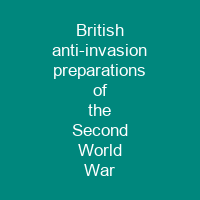British anti-invasion preparations of the Second World War entailed a large-scale division of military and civilian mobilisation. 1.5 million men were enrolled as part-time soldiers in the Home Guard. The rapid construction of field fortifications transformed much of the United Kingdom into a prepared battlefield. Sea Lion was never taken beyond the preliminary assembly of forces.
About British anti-invasion preparations of the Second World War in brief

By 1 October, Poland had been completely overrun. There was little fighting over the months that followed. In a period known as the Phoney War, soldiers on both sides trained for war and the French and British constructed and manned defences on the eastern borders of France. In May 1940, the BEF consisted of 10 infantry divisions in three corps, a tank brigade and a Royal Air Force detachment of around 500 aircraft. The evacuation of British and French forces began on 26 May with air cover provided by the Royal Air force at heavy cost. Over the following ten days, 338,226 French and UK soldiers were evacuated to Britain. Some soldiers even returned without their rifles. Some sources state the British army was lacking in transport. There was a critical shortage of ammunition such that none could be spared for practice. The infantry divisions were, on average, at half strength, had only one-sixth of their normal artillery, with several hundred additional 75-mm M1917 guns and their ammunition arriving from the US. The invasion of Norway was a combined forces operation in which the German war machine projected its power across the sea; this German success would come to be seen by the British as a dire portent. On 7 and 8 May, in the British House of Commons, the Norway Debate revealed intense dissatisfaction with the government of Prime Minister Neville Chamberlain.
You want to know more about British anti-invasion preparations of the Second World War?
This page is based on the article British anti-invasion preparations of the Second World War published in Wikipedia (as of Nov. 14, 2020) and was automatically summarized using artificial intelligence.







